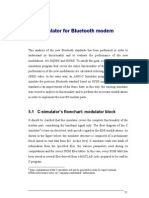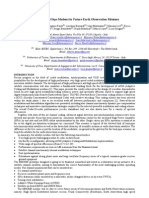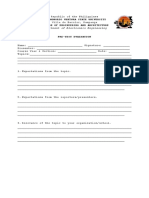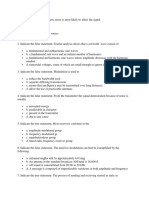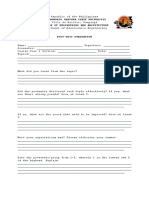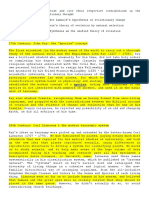Digital Modem Design: by William G. Cowley Australian Space Centre For Signal Processing University of South Australia
Digital Modem Design: by William G. Cowley Australian Space Centre For Signal Processing University of South Australia
Uploaded by
Cristel BautistaCopyright:
Available Formats
Digital Modem Design: by William G. Cowley Australian Space Centre For Signal Processing University of South Australia
Digital Modem Design: by William G. Cowley Australian Space Centre For Signal Processing University of South Australia
Uploaded by
Cristel BautistaOriginal Title
Copyright
Available Formats
Share this document
Did you find this document useful?
Is this content inappropriate?
Copyright:
Available Formats
Digital Modem Design: by William G. Cowley Australian Space Centre For Signal Processing University of South Australia
Digital Modem Design: by William G. Cowley Australian Space Centre For Signal Processing University of South Australia
Uploaded by
Cristel BautistaCopyright:
Available Formats
Chapter 5
DIGITAL MODEM
DESIGN
by William G. Cowley
Australian Space Centre for Signal Processing
University of South Australia
This Chapter considers the modems used in digital communications sys-
tems. In particular, the design and implementation of modems for mobile
satellite (mobilesat) systems will be examined. These modems provide a
good illustration of the need for advanced approaches to modem design
because of the propagation characteristics of the mobiles at channel. The
emphasis will be on using discrete-time signal processing techniques. This
provides greater flexiblity and allows performance closer to the theoretical
optimum. In higher speed modems, approaches combining continuous-time
and discrete-time processing will be examined.
Our attention will be focused on digital modems. Modern systems al-
most invariably encode analog signals (such as speech waveforms) into digi-
tal streams before modulation. In this way digital modulation and channel
coding can be employed for analog as well as digital services as explained in
Chapter 1. Since the most common family of digital modulation methods
is M-PSK modulation, most of the discussion will be concentrated in this
area. Many of the methods are also suitable, perhaps in a modified form, for
systems which use amplitude as well as phase variations of the carrier (e.g.
QAM).
M. J. Miller et al. (eds.), Satellite Communications
© Kluwer Academic Publishers 1993
190 CHAPTER 5. DIGITAL MODEM DESIGN
The general layout of the chapter is as follows. In this section we will start
with a descriptive review of modem functions and then complement this with
a mathematical description of basic modem operation. We also look briefly
at some particular problems of the mobile environment. In the next two
sections we will examine filtering and frequency translation requirements in
modems and how they can be implemented with digital signal processing
techniques. This allows generic discrete-time modulator and demodulator
structures, suitable for programmable implementation, to be suggested in
Section 4. Synchronisation methods are then discussed in the context of
maximum likelihood estimation. Sections 5 and 6 deal with carrier phase
and symbol timing recovery respectively.
5.1 INTRODUCTION
To review the functions of a digital modem, consider the traditional block
diagram of a PSK/QAM modulator and demodulator shown in Figure 5.1.
(0) Modulator
Relo 11.8 ('T-IT- 'T) h T(t)
set)
')0.
'V
(b) Demodulator t=nT+'i'
~----------1~
~-:.l
Yn('T,J<I)
Figure 5.1: Conventional PSK/QAM modem.
You might also like
- 1 - Introduction To Law: The Meaning of LawDocument6 pages1 - Introduction To Law: The Meaning of LawCristel BautistaNo ratings yet
- Manual Service CavitadorDocument29 pagesManual Service CavitadorErik Sanchez HernandezNo ratings yet
- Condor Scissors Lift v2033xl 92350 Parts BookDocument20 pagesCondor Scissors Lift v2033xl 92350 Parts Booksusan100% (58)
- Design and Fabrication of A Power Hacksaw Machine PDFDocument14 pagesDesign and Fabrication of A Power Hacksaw Machine PDFGokul Gocool50% (2)
- Design and Simulation of 2:1 Mux Using Multiple Logic GatesDocument58 pagesDesign and Simulation of 2:1 Mux Using Multiple Logic Gatesdurga manisha100% (1)
- From GSM to LTE-Advanced Pro and 5G: An Introduction to Mobile Networks and Mobile BroadbandFrom EverandFrom GSM to LTE-Advanced Pro and 5G: An Introduction to Mobile Networks and Mobile BroadbandNo ratings yet
- Chapter 4-Compare and Contrast-Transport EtcDocument34 pagesChapter 4-Compare and Contrast-Transport EtcCristel BautistaNo ratings yet
- Handbook of Thermodynamic Diagrams Volume 3 PDFDocument407 pagesHandbook of Thermodynamic Diagrams Volume 3 PDFcyclon2010No ratings yet
- ASCLD-LAB Legacy Manual 2005Document119 pagesASCLD-LAB Legacy Manual 2005jac_blake100% (2)
- A Brief Introduction To Time-to-Digital and Digital-to-Time ConvertersDocument5 pagesA Brief Introduction To Time-to-Digital and Digital-to-Time Convertersjulio perezNo ratings yet
- Introduction To Digital Data TransmissionDocument66 pagesIntroduction To Digital Data TransmissionArefin HasibNo ratings yet
- Impact of Signal Transition Time On Path Delay Computation - IEEETransCirSysIIDocument8 pagesImpact of Signal Transition Time On Path Delay Computation - IEEETransCirSysIIscribddderNo ratings yet
- Simulation of Digital Modulation TechniquesDocument67 pagesSimulation of Digital Modulation TechniquesEkta KumariNo ratings yet
- Arkadiy Morgenshtein', Alexander Fish2 and Israel A. Wagner'Document4 pagesArkadiy Morgenshtein', Alexander Fish2 and Israel A. Wagner'Sathish KumarNo ratings yet
- Design of Folded Cascode OTA in Different Regions of Operation Through gmID Methodology PDFDocument6 pagesDesign of Folded Cascode OTA in Different Regions of Operation Through gmID Methodology PDFAyush MalhotraNo ratings yet
- Gate-Diffusion Input (GDI) A Power Efficient Method For Digital Combinatorial CircuitsDocument16 pagesGate-Diffusion Input (GDI) A Power Efficient Method For Digital Combinatorial Circuitsmdzakir_hussainNo ratings yet
- An Efficient Cordic Processor For Complex Digital Phase Locked LoopDocument7 pagesAn Efficient Cordic Processor For Complex Digital Phase Locked LoopInternational Journal of Application or Innovation in Engineering & ManagementNo ratings yet
- Btech Project On GSM Modem Pic16f877a ControllerDocument52 pagesBtech Project On GSM Modem Pic16f877a ControllerTafadzwa Murwira100% (4)
- Gate Diffusion InputDocument37 pagesGate Diffusion InputRuthvik Rachakonda71% (7)
- Ijesrt: A Verilog Design in FPGA Implementation of Quadrature Phase Shift Keying (QPSK) Digital ModulatorDocument6 pagesIjesrt: A Verilog Design in FPGA Implementation of Quadrature Phase Shift Keying (QPSK) Digital ModulatorRahulNo ratings yet
- Chapter 5 Introduction To Digital Data Transmission PDFDocument66 pagesChapter 5 Introduction To Digital Data Transmission PDFJoel TibebuNo ratings yet
- Flexible M-Qam Modulator and Scalablefft/Ifft: Design and Implementation For A Sdrmulti-Carrier Transmitter With Link AdaptationDocument9 pagesFlexible M-Qam Modulator and Scalablefft/Ifft: Design and Implementation For A Sdrmulti-Carrier Transmitter With Link AdaptationIvancica RamljakNo ratings yet
- Digital Logic Cancellation Block For A Cascade Feed-ForwardDocument4 pagesDigital Logic Cancellation Block For A Cascade Feed-ForwardGlaiza PagasNo ratings yet
- Arkadiy Morgenshtein', Alexander Fish2 and Israel A. Wagner'Document4 pagesArkadiy Morgenshtein', Alexander Fish2 and Israel A. Wagner'yaashiNo ratings yet
- A Jitter Injection Signal Generation and ExtractioDocument14 pagesA Jitter Injection Signal Generation and Extractioيبسسي سيسيسيNo ratings yet
- 2009 Tayab and Walliullah IC4 Copy of The Paper PDFDocument6 pages2009 Tayab and Walliullah IC4 Copy of The Paper PDFtayabmemonNo ratings yet
- TDC VerifiedDocument8 pagesTDC VerifiedeejlnyNo ratings yet
- Design of Folded Cascode OTA in Different Regions of Operation Through G /I MethodologyDocument6 pagesDesign of Folded Cascode OTA in Different Regions of Operation Through G /I MethodologyPramod SrinivasanNo ratings yet
- Solid-State T - R Module Design and Modeling For Radar Applications - Microwave Product DigestDocument6 pagesSolid-State T - R Module Design and Modeling For Radar Applications - Microwave Product DigestMahesh BirariNo ratings yet
- ROBOTCONTROLDocument83 pagesROBOTCONTROLAnkhina KaushikNo ratings yet
- Wireless Measurement System For CDMA Base Station Transmit PowerDocument4 pagesWireless Measurement System For CDMA Base Station Transmit PowerMohit PatelNo ratings yet
- Emulation of Automotive Communication Protocol Single Edge Nibble Transmission (SENT) Using Aurix Family of MicrocontrollersDocument4 pagesEmulation of Automotive Communication Protocol Single Edge Nibble Transmission (SENT) Using Aurix Family of MicrocontrollersseventhsensegroupNo ratings yet
- Fdocuments - in Pscad-ModelingDocument21 pagesFdocuments - in Pscad-ModelingniteshNo ratings yet
- System HardwareDocument56 pagesSystem HardwareSamuelNo ratings yet
- Fundamentals of Spread Spectrum ModulationDocument86 pagesFundamentals of Spread Spectrum ModulationBa Dong100% (1)
- Equalilzat'ion SC-FDE Test-Bed: 'UniversityDocument4 pagesEqualilzat'ion SC-FDE Test-Bed: 'UniversityGayathri KongaraNo ratings yet
- Software Defined Radio Implementation of A DVB S Transceiver PaperDocument5 pagesSoftware Defined Radio Implementation of A DVB S Transceiver PaperLalchand MangalNo ratings yet
- GSM Based DC Motor ControlDocument56 pagesGSM Based DC Motor Controlhamed razaNo ratings yet
- Design of A Wireless Laser Communication System Based On PPM TechniqueDocument4 pagesDesign of A Wireless Laser Communication System Based On PPM TechniqueMelvin AntonyNo ratings yet
- Ofdm Simulation MatlabDocument21 pagesOfdm Simulation MatlabAnderson Soares AraujoNo ratings yet
- C-Simulator For Bluetooth ModemDocument12 pagesC-Simulator For Bluetooth ModemMuhammad AttiqueNo ratings yet
- Hybrid Pon Omnetpp2011Document8 pagesHybrid Pon Omnetpp2011blizanac87No ratings yet
- IT-702 WMC Assignment Unit 1: Q.N o Questions MarksDocument3 pagesIT-702 WMC Assignment Unit 1: Q.N o Questions MarksamaniNo ratings yet
- Analysis of Various Delay Elements 16-nm Technology NodeDocument6 pagesAnalysis of Various Delay Elements 16-nm Technology Node3522874398No ratings yet
- 4 Bit Fast Adder Design Topology and Layout With Self Resetting Logic For Low Power VLSI Circuits 197 205Document9 pages4 Bit Fast Adder Design Topology and Layout With Self Resetting Logic For Low Power VLSI Circuits 197 205MohamedNo ratings yet
- The MHOMS 1Gbps Modem For Future Earth Observation Missions: EmailDocument12 pagesThe MHOMS 1Gbps Modem For Future Earth Observation Missions: Emailarchean01No ratings yet
- Data Communication Codes, Formats and Data Communications EquipmentDocument18 pagesData Communication Codes, Formats and Data Communications EquipmentMukesh83% (6)
- Project BookDocument68 pagesProject Bookbabuhajju18No ratings yet
- Simulation of A CDMA Systems Using Linear Prediction and MUD (Matlab)Document44 pagesSimulation of A CDMA Systems Using Linear Prediction and MUD (Matlab)Raj Kumar100% (2)
- TTTSDK-3.3.2 DocsDocument43 pagesTTTSDK-3.3.2 DocspradeepincNo ratings yet
- Mehrpoo2019 PDFDocument5 pagesMehrpoo2019 PDFDigvijayNo ratings yet
- 5G NR PhyDocument13 pages5G NR PhyBrian HabibNo ratings yet
- eNodeB Power Saving in LTE NetworkDocument6 pageseNodeB Power Saving in LTE Networkakoe ajaNo ratings yet
- UncertaintyDocument24 pagesUncertaintyramana459No ratings yet
- Asc 01161r0P80Document23 pagesAsc 01161r0P80goodshanmugamNo ratings yet
- Lab Exercises:: Implementing An OFDM Transceiver by Software Defined RadioDocument37 pagesLab Exercises:: Implementing An OFDM Transceiver by Software Defined Radiozoom zoumbaNo ratings yet
- TM TC For NanosatelliteDocument4 pagesTM TC For NanosatelliteSreeja SujithNo ratings yet
- XIA - Study of Multicarrier ModulationDocument6 pagesXIA - Study of Multicarrier ModulationAnonymous PsEz5kGVaeNo ratings yet
- Analysis of CMOS 45nm Transmission Gate Based Pulsed Latch AbstractDocument12 pagesAnalysis of CMOS 45nm Transmission Gate Based Pulsed Latch AbstractbaluNo ratings yet
- Marc C. Steinbach H. Georg Bock Georgii V. Kostin Richard W. LongmanDocument43 pagesMarc C. Steinbach H. Georg Bock Georgii V. Kostin Richard W. LongmanJohn RobinsonNo ratings yet
- Implementation of A PID Control System On Microcontroller (DC Motor Case Study)Document5 pagesImplementation of A PID Control System On Microcontroller (DC Motor Case Study)Monata Sera100% (1)
- Modeling A Link Level Simulator For Long Term Evolution UplinkDocument5 pagesModeling A Link Level Simulator For Long Term Evolution UplinkMihaela HainarosieNo ratings yet
- Ultra High-Speed SONET Fiber-Optic Transmission System: Takashi Mori Hirokuni Tsuji Hiroyuki Nakano, D.E. Shigeo ShinadaDocument6 pagesUltra High-Speed SONET Fiber-Optic Transmission System: Takashi Mori Hirokuni Tsuji Hiroyuki Nakano, D.E. Shigeo ShinadatranquocvinhtechNo ratings yet
- Chapter 1b: Circuit Switching: ETM 7012 Transmission & Switching: SwitchingDocument45 pagesChapter 1b: Circuit Switching: ETM 7012 Transmission & Switching: Switchingkhaled loteesNo ratings yet
- VLSI unit-4 2marksDocument4 pagesVLSI unit-4 2marksAnitha SNo ratings yet
- Self-Recovering Equalization and Carrier Tracking in Two-Dimensional Data Communication SystemsDocument9 pagesSelf-Recovering Equalization and Carrier Tracking in Two-Dimensional Data Communication SystemsMANISH KUMARNo ratings yet
- Frequency Shift-Keying: Also Known As FSKDocument33 pagesFrequency Shift-Keying: Also Known As FSKCristel BautistaNo ratings yet
- Cost Charged To Department II Total in Process Added Unit Cost 1-Oct This Month EUP CostDocument7 pagesCost Charged To Department II Total in Process Added Unit Cost 1-Oct This Month EUP CostCristel BautistaNo ratings yet
- Completed Current MonthDocument17 pagesCompleted Current MonthCristel BautistaNo ratings yet
- Bautista, Cristel V. Engr. Mark Anthony Castro Bs Ece - 2B February 11, 2020Document2 pagesBautista, Cristel V. Engr. Mark Anthony Castro Bs Ece - 2B February 11, 2020Cristel BautistaNo ratings yet
- 1 Review of Communication Systems, Transistor Models, and Distortion GenerationDocument2 pages1 Review of Communication Systems, Transistor Models, and Distortion GenerationCristel BautistaNo ratings yet
- Thyristor Project: Light Dimmer: January 2019Document8 pagesThyristor Project: Light Dimmer: January 2019Cristel BautistaNo ratings yet
- ASK Multisim Simulation PDFDocument2 pagesASK Multisim Simulation PDFCristel BautistaNo ratings yet
- Wideband 90° Phase Shifters: O. IH (JW) 1 - (7rDocument2 pagesWideband 90° Phase Shifters: O. IH (JW) 1 - (7rCristel BautistaNo ratings yet
- Pre TestDocument1 pagePre TestCristel BautistaNo ratings yet
- Gantt Chart (Am Superheterodyne Reciever) : 1 Research 2 Brainstorming 3 Schematic 4 Buying 5 TestingDocument2 pagesGantt Chart (Am Superheterodyne Reciever) : 1 Research 2 Brainstorming 3 Schematic 4 Buying 5 TestingCristel BautistaNo ratings yet
- 1Document2 pages1Cristel BautistaNo ratings yet
- Post Test Me For ReportingDocument1 pagePost Test Me For ReportingCristel BautistaNo ratings yet
- Species: Naturae". The "Systema" Built On Ray's Earlier Work and Catalogued TheDocument8 pagesSpecies: Naturae". The "Systema" Built On Ray's Earlier Work and Catalogued TheCristel BautistaNo ratings yet
- I'Ll Start My Diet Tomorrow - A Solution-Focused Approach To Weight LossDocument8 pagesI'Ll Start My Diet Tomorrow - A Solution-Focused Approach To Weight Losssolutions4familyNo ratings yet
- Cercospora Zeae-Maydis: Sclerotinia SclerotiorumDocument3 pagesCercospora Zeae-Maydis: Sclerotinia SclerotiorumUnodosNo ratings yet
- Siahtiri 2014Document19 pagesSiahtiri 2014maleeha mushtaqNo ratings yet
- Group Assignment FinalDocument26 pagesGroup Assignment FinalIqbal JoyNo ratings yet
- Wajo 18 QnsolnDocument16 pagesWajo 18 QnsolnSmpnsatubontang KaltimNo ratings yet
- Legal Education in Regional Languages in 21st Century India - A QuagmireDocument7 pagesLegal Education in Regional Languages in 21st Century India - A Quagmiresaqib nisarNo ratings yet
- Open Sample SCI1020Document20 pagesOpen Sample SCI1020JoeNo ratings yet
- Musnad Isnad EtcDocument22 pagesMusnad Isnad EtcAbul HasanNo ratings yet
- Educ25738 Week 4Document43 pagesEduc25738 Week 4api-434247026No ratings yet
- Physics Unit 4 PDFDocument49 pagesPhysics Unit 4 PDFJhon ThomasNo ratings yet
- Analysis of Settlement Planning in The Lantawe Coastal Area, Napano Kusambi District, West Muna RegencyDocument9 pagesAnalysis of Settlement Planning in The Lantawe Coastal Area, Napano Kusambi District, West Muna Regencyzen dartNo ratings yet
- Marker Based Maze Game Developed On Unity Software: A Project Report OnDocument22 pagesMarker Based Maze Game Developed On Unity Software: A Project Report OnshashwatNo ratings yet
- HawaiianbeliefsDocument33 pagesHawaiianbeliefsapi-280221981100% (3)
- List of Agencies With Recognition Status and ApplyingDocument7 pagesList of Agencies With Recognition Status and ApplyingReginNo ratings yet
- PittingDocument14 pagesPittingrizky febrianNo ratings yet
- Water Hammer FormingDocument7 pagesWater Hammer FormingHariNo ratings yet
- Algebrasheet 2Document8 pagesAlgebrasheet 2shivam guptaNo ratings yet
- TOS in Principle and Theories of Language Acquisition and LearningDocument2 pagesTOS in Principle and Theories of Language Acquisition and LearningRiza Quider Bedayo100% (1)
- Peri Op FINAL OBJECTIVES May 2021Document12 pagesPeri Op FINAL OBJECTIVES May 2021Omar SanyangNo ratings yet
- 1 Compact Topological Spaces: Math 490: Worksheet #16Document2 pages1 Compact Topological Spaces: Math 490: Worksheet #16Supriya DuttaNo ratings yet
- Construction of 230 KV UNd CableDocument6 pagesConstruction of 230 KV UNd CableterimakabosraNo ratings yet
- Tqs Evaluation Report - Alison WildDocument5 pagesTqs Evaluation Report - Alison Wildapi-412576686No ratings yet
- Math Hunters 1: GonitzoggoDocument10 pagesMath Hunters 1: GonitzoggoUniverse gamerNo ratings yet
- Worksheet Unit 3 Planning, Collecting Data, Processing, Presenting Data and ProbabilityDocument10 pagesWorksheet Unit 3 Planning, Collecting Data, Processing, Presenting Data and Probabilitypanida SukkasemNo ratings yet








































